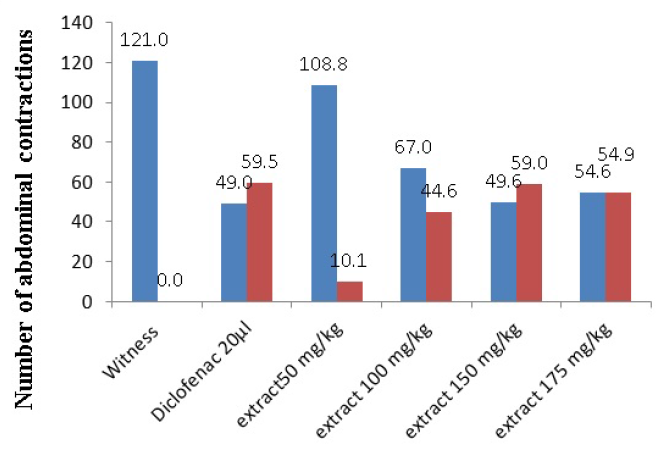Analgesic and anti-inflammatory activity of aqueous extract of Bubonium graveolens
DOI:
https://doi.org/10.15419/bmrat.v7i9.632Keywords:
Bubonium graveolens, analgesic activity, aqueous extract essential oilsAbstract
Introduction: Bubonium graveolens is used in traditional pharmacopoeia against imbalances of the gastrointestinal tract, cephalic pains, and bronchitis, and as an anti-inflammatory agent.
Methods: We have investigated the analgesic and anti-inflammatory activities of the aqueous extract of Bubonium graveolens in male mice of strain NMRI Albinos, weighing between 22 g and 38 g. Acetic acid was used to induce writhes in the mice and inflammation of paw edema.
Results: Evaluation of the analgesic activity showed that the aqueous extract at 150 mg/kg of the plant induced a decrease in the number of abdominal cramps caused by 1% acetic acid. The aqueous extract of the plant had an analgesic effect almost equal to that of Diclofenac; in fact, the latter caused a pain inhibition of 49 ± 1.1% while Bubonium graveolens caused a pain inhibition of 49.6 ± 2.1%, at the concentration of 150 mg/kg. Evaluation of the percentage of inhibition showed that the aqueous extract of Bubonium graveolens had a better anti-inflammatory activity compared to Diclofenac sodium during the treatment duration (69.57% — 56.52% at 60 min; 71.43% — 50.00% at 120 min, and 75.00% — 66.67% at 180 min).
Conclusion: The results of this research indicate that Bubonium graveolens inhibits inflammation and could explain its effective use in traditional medicine.

Downloads
Published
Issue
Section
License
Copyright The Author(s) 2017. This article is published with open access by BioMedPress. This article is distributed under the terms of the Creative Commons Attribution License (CC-BY 4.0) which permits any use, distribution, and reproduction in any medium, provided the original author(s) and the source are credited.
